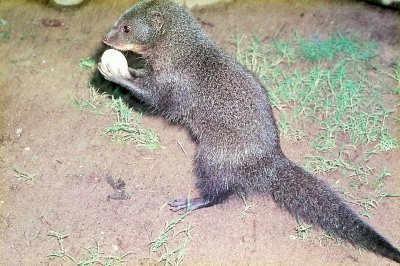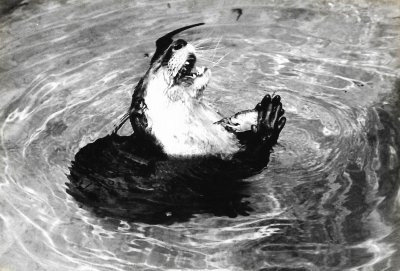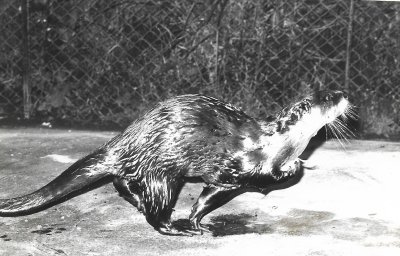IUCN/SSC Otter Specialist Group Bulletin

©IUCN/SCC Otter Specialist Group
Volume 35 Issue 1 (January 2018)
Citation: Rowe-Rowe, DT (2018). Anvil-Use by Aonyx capensis: a Rebuttal. IUCN Otter Spec. Group Bull. 35 (1): 62 - 65
Anvil-Use by Aonyx capensis: a Rebuttal
David T. Rowe-Rowe1*
1 97 Frances Staniland Road, Pietermaritzburg, 3201, South Africa e-mail - dtr.rowe@gmail.com

|
| (Received 19th January 2018, accepted 28th January 2018) |
| Download PDF (1.09 MB) |
| Abstract: The claim that Aonyx capensis uses anvils to break open hard prey is rejected. It is believed that the authors who originally made the claim that the otter had used anvils to open freshwater mussels, based on signs in the field and not on direct observations, ignored the more likely possibility that the anvils had been used by the water mongoose Atilax paludinosus, which does employ this type of behaviour. |
| Française | Español |
A number of authors, e.g. Estes (1989), Larivière (2001), Mason and Macdonald (2009), Nowak (1999), and Sheppey and Bernard (1984) have referred to anvil using behaviour by the Cape clawless otter Aonyx capensis, based on the original statement by Donnelly and Grobler (1976). The observations by Donnelly and Grobler (1976) were made in Rhodes Matopos National Park (in present Zimbabwe), when after a dry spell, dam (impoundment) levels dropped and the shoreline receded about 5 m, exposing freshwater mussels embedded the mud. The authors noted that there were concentrations of mussel shells around hard objects such as rocks, logs, and even bottles and a metal pipe, and assumed that otters had used these objects as anvils to break open the mussels. One of the photographs, however, in which they show clawless otter tracks in the mud at an anvil site, also shows numerous water mongoose Atilax paludinosus tracks to and from the anvil (a log).
Donnelly and Grobler (1976) did not actually see otters using anvils and make no reference to their possible use by water mongooses, that do use anvils to open hard objects (Baker, 1989; Rowe-Rowe, 1978). When dealing with hard-shelled items (e g. eggs, snails, mussels) the water mongoose grasps it in its fore feet, stands on its hind legs, then throws the object downwards (Fig. 1). If it does not succeed in opening it, the mongoose takes it to the nearest hard object which it uses as an anvil.

|
| Figure 1. A water mongoose preparing to throw an egg downwards to break it. (click for larger version) |
Anvil-use was never observed by Rowe-Rowe (1975, 1977) during 19 months of observation and feeding trials on an adult female A. capensis; neither in many hours of field observations in subsequent years. Hard-shelled prey is always dealt with by crushing it with its powerful molars (Rowe-Rowe, 1977; Rowe and Somers, 1998). A. capensis often does grasp prey in both fore feet while feeding (Fig. 2), but was never seen throwing prey downwards; almost always consuming its prey in the water. In the captive otter, if it needed to transport food to the water, it grasped it in one fore foot, and while holding it against its chest, hobbled on three legs to the water (Fig. 3).

|
| Figure 2. A. capensis eating a large crab, holding it in both fore feet. (click for larger version) |

|
| Figure 3. A. capensis carrying food to be consumed in the water. (click for larger version) |
Regarding the otter tracks which Donnelly and Grobler (1976) observed leading to the mussel shells, my opinion is that the otter visited the site, which was close to the water, out of curiosity. In some mammal surveys that I conducted I used scent posts (Linhart and Knowlton 1975) to attract carnivores for identification from tracks. Scent posts set beside water bodies were often visited by A. capensis, apparently out of curiosity.
In conclusion, I am of the opinion that Aonyx capensis does not indulge in anvil-using behaviour to open prey.
REFERENCES
Baker, C.M. (1989). Feeding habits of the water mongoose (Atilax paludinosus). Zeitschrift für Säugetierkunde 54: 31-39.
Donnelly, R.G., Grobler, J.H. (1976). Notes on food and anvil using behaviour by the Cape clawless otter, Aonyx capensis, in the Rhodes Matopos National Park, Rhodesia. Arnoldia 7(37): 1-8.
Estes, J.A. (1989). Adaptations for aquatic living carnivores. pp. 242-287. In: Gittleman, JL (1989) Carnivore behaviour, ecology, and evolution. Springer.
Larivière, S. (2001). Aonyx capensis. Mammalian Species. 671: 1-6.
Linhart, S.B., Knowlton, F.F. (1975). Determining the relative abundance of coyotes by scent station lines. Wildl. Soc. Bull. 3: 119-124.
Mason, C.F., Macdonald, S.M. (2009). Otters: Ecology and conservation. Cambridge University Press.
Nowak, R.M. (1999). Walker’s Carnivores of the world. John Hopkins University Press.
Rowe-Rowe, D.T. (1975). Biology of Natal mustelids. MSc thesis. University of Natal, Durban.
Rowe-Rowe, D.T. (1977). Prey capture and feeding behaviour of South African otters. Lammergeyer 23: 13-21.
Rowe-Rowe, D.T. (1978). The small carnivores of Natal. Lammergeyer 25: 1-48.
Rowe-Rowe, D.T., Somers, M.J. (1998). Diet, foraging behaviour and coexistence of African otters and the water mongoose. Symp. Zool. Soc. Lond. 71, 215-227.
Sheppey, K., Bernard, R.T.F. (1984). Relative brain size in the mammalian carnivores of the Cape Province of South Africa. S. Afr. J Zool. 19: 305- 08.
Résumé : L’utilisation d’une Enclume par la Loutre à Joues Blanches, Aonyx Capensis: un Démenti
L’affirmation selon laquelle Aonyx capensis utilise des enclumes pour casser une proie dure est fortement contestable. Il est admis que les auteurs qui avaient au départ lancé l’affirmation que la loutre avait utilisé des enclumes pour ouvrir des moules d’eau douce, basée sur des indices de terrain et non sur des observations directes, ignoraient que la possibilité la plus probable serait que les enclumes aient été utilisées par la mangouste des marais, Atilax paludinosus, qui a ce type de comportement.
Revenez au dessus
Resumen: Uso De “Yunques” Por Aonyx Capensis: Refutación
La postulación de que Aonys capensis utiliza “yunques” para romper y abrir presas duras, es rechazada. Se cree que los autores que originalmente postularon que la nutria había usado “yunques” para abrir almejas de agua dulce, basándose en signos en terreno y no en observaciones directas, ignoraron la posibilidad más probable, de que los “yunques” hayan sido usados por la mangosta acuática Atilax paludinosus, que sí emplea este tipo de comportamiento
Vuelva a la tapa